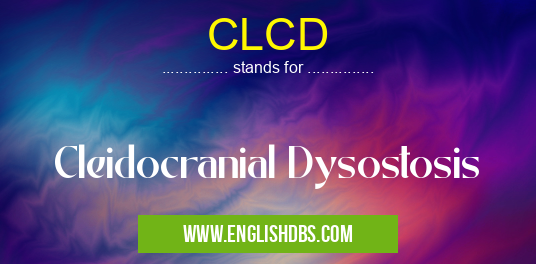What does CLCD mean in SYNDROMES
Cleidocranial dysostosis (CCD) is a rare genetic disorder that can affect bones and teeth. It is characterized by a number of symptoms, including the partial or complete absence of collarbones, delayed closure of some skull sutures, underdeveloped clavicles and shoulder blades, partially fused vertebrae, short stature and dental problems such as supernumerary teeth.

CLCD meaning in Syndromes in Medical
CLCD mostly used in an acronym Syndromes in Category Medical that means Cleidocranial Dysostosis
Shorthand: CLCD,
Full Form: Cleidocranial Dysostosis
For more information of "Cleidocranial Dysostosis", see the section below.
Essential Questions and Answers on Cleidocranial Dysostosis in "MEDICAL»SYNDROMES"
What is Cleidocranial Dysostosis?
Cleidocranial dysostosis (CCD) is a rare genetic disorder that can affect bones and teeth. It is characterized by a number of symptoms including the partial or complete absence of collarbones, delayed closure of some skull sutures, underdeveloped clavicles and shoulder blades, partially fused vertebrae, short stature and dental problems such as supernumerary teeth.
What are the symptoms of CCD?
The most common symptoms associated with CCD are the partial or complete absence of collarbones, delayed closure of some skull sutures, underdeveloped clavicles and shoulder blades, partially fused vertebrae and short stature. Dental issues such as supernumerary teeth are also common in those with CCD.
Who can be affected by CCD?
While it is rare in general population, CCD can affect anyone regardless of their race or gender.
How is CCD inherited?
CCD is inherited in an autosomal dominant pattern; this means that having one copy of the mutated gene in each cell is enough to cause the condition.
Are there treatments available for CCD?
While there is currently no cure for this condition, there are treatments to manage its symptoms. These can include physical therapy to help improve muscle strength and range-of-motion exercises; orthodontic treatment to address dental problems; surgery for skeletal deformities; speech therapy; occupational therapy; and psychosocial support for emotional challenges caused by the condition.
Final Words:
Cleidocranial dysostosis (CCD) is a rare genetic disorder that affects bones and teeth. It has many associated symptoms which can be treated through various methods to help improve quality of life for those affected by it.
